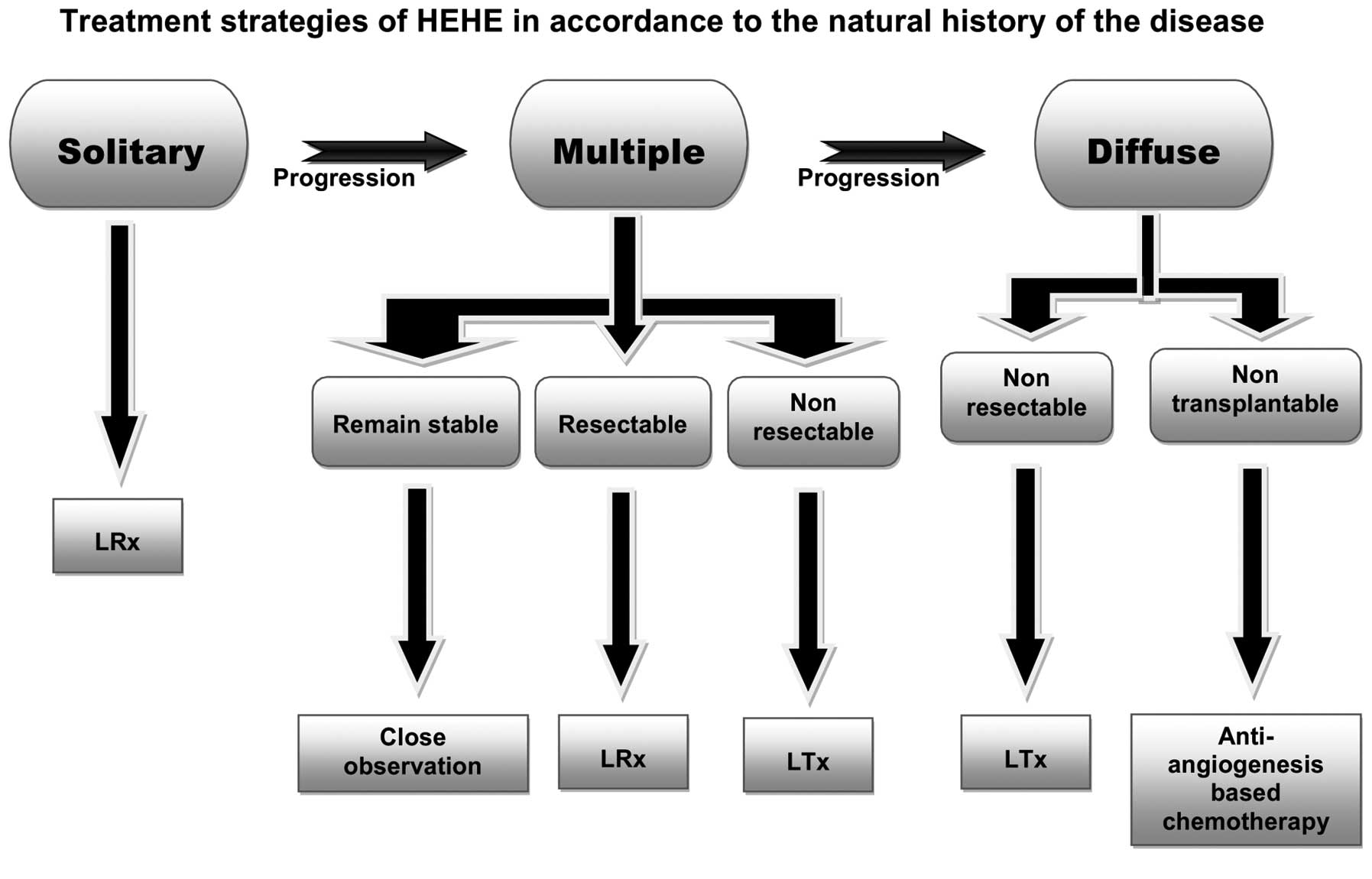|
1
|
Weiss SW and Enzinger FM: Epithelioid
hemangioendothelioma: a vascular tumor often mistaken for a
carcinoma. Cancer. 50:970–981. 1982. View Article : Google Scholar
|
|
2
|
Komatsu Y, Koizumi T, Yasuo M, et al:
Malignant hepatic epithelioid hemangioendothelioma with rapid
progression and fatal outcome. Intern Med. 49:1149–1153. 2010.
View Article : Google Scholar : PubMed/NCBI
|
|
3
|
Makhlouf HR, Ishak KG and Goodman ZD:
Epithelioid hemangioendothelioma of the liver: a clinicopathologic
study of 137 cases. Cancer. 85:562–582. 1999. View Article : Google Scholar : PubMed/NCBI
|
|
4
|
Thin LW, Wong DD, De Boer BW, et al:
Hepatic epithelioid haemangioendothelioma: challenges in diagnosis
and management. Intern Med J. 40:710–715. 2010. View Article : Google Scholar : PubMed/NCBI
|
|
5
|
Mehrabi A, Kashfi A, Fonouni H, Schemmer
P, Schmied BM and Hallscheidt P: Primary malignant hepatic
epithelioid hemangioendothelioma: a comprehensive review of the
literature with emphasis on the surgical therapy. Cancer.
107:2108–2121. 2006. View Article : Google Scholar
|
|
6
|
Zhao AL, Zhou LX and Li XH: Hepatic
epithelioid hemangioendothelioma in needle biopsy specimens: report
of 5 cases with review of literature. Zhonghua Bing Li Xue Za Zhi.
40:23–26. 2011.(In Chinese).
|
|
7
|
Chen Y, Yu RS, Qiu LL, Jiang DY, Tan YB
and Fu YB: Contrast-enhanced multiple-phase imaging features in
hepatic epithelioid hemangioendothelioma. World J Gastroenterol.
17:3544–3553. 2011. View Article : Google Scholar : PubMed/NCBI
|
|
8
|
Shi Y and Hou YY: Hepatic epithelioid
hemangioendothelioma: a case report. Zhonghua Bing Li Xue Za Zhi.
34:3832005.(In Chinese).
|
|
9
|
Lin J and Ji Y: CT and MRI diagnosis of
hepatic epithelioid hemangioendothelioma. Hepatobiliary Pancreat
Dis Int. 9:154–158. 2010.PubMed/NCBI
|
|
10
|
Ji ZF, Shen XZ, Zhang DY, Liu HY, Zhou Y,
Guo MY and Dong L: Hepatic epithelioid hemangioendothelioma: a
report of six patients. J Dig Dis. 11:254–258. 2010.PubMed/NCBI
|
|
11
|
Lau WY, Dewar GA and Li AK: Spontaneous
rupture of hepatic epithelioid haemangio-endothelioma. Aust N Z J
Surg. 59:972–9744. 1989. View Article : Google Scholar : PubMed/NCBI
|
|
12
|
Hsieh MS, Liang PC, Kao YC and Shun CT:
Hepatic epithelioid hemangioendothelioma in Taiwan: a
clinicopathologic study of six cases in a single institution over a
15-year period. J Formos Med Assoc. 109:219–227. 2010.
|
|
13
|
Lee HF, Lu CL and Chang FY: Electronic
clinical challenges and images in GI. Multiple hepatic tumors with
hemoperitoneum. Gastroenterology. 138:e3–e4. 2010. View Article : Google Scholar : PubMed/NCBI
|
|
14
|
Shen CH, Tsai MH, Chen TC, Liu NJ and
Sheen IS: Primary hepatic epithelioid hemangioendothelioma: case
report. Changgeng Yi Xue Za Zhi. 22:486–491. 1999.PubMed/NCBI
|
|
15
|
Zang SH, Cong WM and Wu MC: Epithelioid
hemangioendothelioma of the liver : a clinicopathological study on
8 cases and review of literature. Zhonghua Gan Dan Wai Ke Za Zhi.
6:327–330. 2003.
|
|
16
|
Ishak KG, Sesterhenn IA, Goodman ZD, Rabin
L and Stromeyer FW: Epithelioid hemangioendothelioma of the liver:
a clinicopathologic and follow-up study of 32 cases. Hum Pathol.
15:839–852. 1984. View Article : Google Scholar : PubMed/NCBI
|
|
17
|
Rodriguez JA, Becker NS, O’Mahony CA, Goss
JA and Aloia TA: Long-term outcomes following liver transplantation
for hepatic hemangioendothelioma: the UNOS experience from 1987 to
2005. J Gastrointest Surg. 12:110–116. 2008. View Article : Google Scholar : PubMed/NCBI
|
|
18
|
Lerut JP, Orlando G, Adam R, et al: The
place of liver transplantation in the treatment of hepatic
epitheloid hemangioendothelioma: report of the European liver
transplant registry. Ann Surg. 246:949–957; discussion 57. 2007.
View Article : Google Scholar
|
|
19
|
Madariaga JR, Marino IR, Karavias DD, et
al: Long-term results after liver transplantation for primary
hepatic epithelioid hemangioendothelioma. Ann Surg Oncol.
2:483–487. 1995. View Article : Google Scholar
|
|
20
|
Nudo CG, Yoshida EM, Bain VG, et al: Liver
transplantation for hepatic epithelioid hemangioendothelioma: the
Canadian multicentre experience. Can J Gastroenterol. 22:821–824.
2008.PubMed/NCBI
|
|
21
|
Salech F, Valderrama S, Nervi B, et al:
Thalidomide for the treatment of metastatic hepatic epithelioid
hemangioendothelioma: a case report with a long term follow-up. Ann
Hepatol. 10:99–102. 2011.
|
|
22
|
Raphael C, Hudson E, Williams L, Lester JF
and Savage PM: Successful treatment of metastatic hepatic
epithelioid hemangioendothelioma with thalidomide: a case report. J
Med Case Rep. 4:4132010. View Article : Google Scholar : PubMed/NCBI
|
|
23
|
Mascarenhas RC, Sanghvi AN, Friedlander L,
Geyer SJ, Beasley HS and Van Thiel DH: Thalidomide inhibits the
growth and progression of hepatic epithelioid hemangioendothelioma.
Oncology. 67:471–475. 2004. View Article : Google Scholar : PubMed/NCBI
|
|
24
|
Grotz TE, Nagorney D, Donohue J, et al:
Hepatic epithelioid haemangioendothelioma: is transplantation the
only treatment option? HPB (Oxford). 12:546–553. 2010. View Article : Google Scholar
|
|
25
|
Wang LR, Zhou JM, Zhao YM, et al: Clinical
experience with primary hepatic epithelioid hemangioendothelioma:
retrospective study of 33 patients. World J Surg. 36:2677–2683.
2012. View Article : Google Scholar
|













